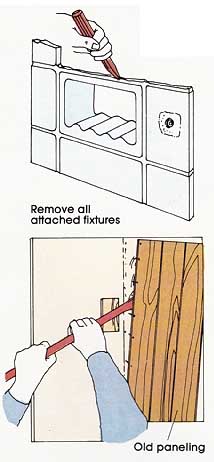You want to make your wall surfaces as smooth as possible. Remove old tiles and wallpaper, sand painted surfaces, and repair cracks and holes. If you’re planning to install recessed items, a tub, or a shower stall, do so be fore repairing walls
Supplies: liquid wallpaper remover; sponge; sand-paper; wire-mesh screen; spackling compound; epoxy.
Tools: Tile—screwdriver; mallet or hammer; cold chisel. Wallpaper—sprayer; stiff-bladed scraper; wallpaper- steamer (optional). Paint—putty knife. Paneling—prybar; nail puller; hammer.
1. Remove tile wails in exactly the same way as tile floors. You may have wall damage caused by moisture accumulating behind the tiles, Repair minor damage as shown below. Before removing tiles, take off accessories. Metal accessories, attached with screws, are easily removed, but you will have to chip ceramic accessories free. If you want to save them, be careful, but don’t count on happy results.
2. Remove stubborn patches of wallpaper by spraying them with a liquid wallpaper remover solution—enough for the moisture to reach the paste underneath. Scrape the soaked paper from the wall, beginning at the floor and working at an angle toward the ceiling. If spraying doesn’t loosen the paper, soak a sponge in the solution, apply directly to the paper, and then scrape; if all fails, rent a steamer. If your old wall surface is paint, you should chip away any loose, flaking areas with a putty knife, and sand the areas immediately surrounding them very lightly so that new paint will adhere to your wall.
3. Remove paneling with a pry-bar and nail puller. Sometimes the glue will pull off sections of the wall. Work carefully to minimize this problem.
4. Repair cracks or holes in the wall before applying a new wall surface. Small holes can be spackled over and allowed to dry. Open larger cracks farther, using a chisel or putty knife, so that you can clean them out and smooth their edges before patching. If the holes or cracks are too large to use spackling compound, buy a small section of ordinary window screen or some other wire mesh in a non-rusting material. Cut a piece slightly larger than the hole you want to patch, and push it into the hole. Bind it to the inside of the wall with instant-bond glue or epoxy. When it has set, patch over the mesh with spackling compound or plaster. In the event that the wall beneath your paper is seriously damaged, you may need to perform more extensive wall repairs. For specific instructions on this kind of task, see Basic Home Repairs.



Wallpaper remover solution; Scrape softened paper from wall
Next: Installing Your New Bathroom
Prev.: Dismantling Floor Surfaces